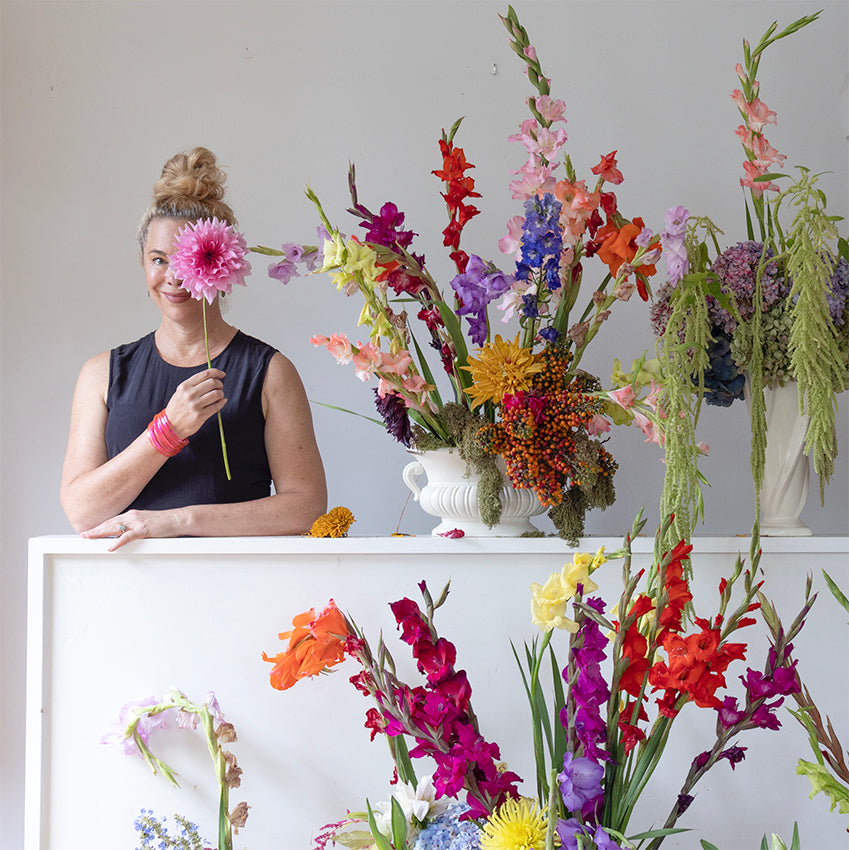Art New Zealand magazine
May 22, 2023



Emma Bass: Assemblages.
Emma Bass has made her reputation as an artist with her colourful and flamboyant photographs of flowers. Not that her career began this way for her current works have had a long gestation period. Although she associated with artists while growing up, did life drawing and etching classes with Carole Shepheard at A.S.A. as a teenager and thought of going to Elam, in the end she decided on a career in nursing. She went to London as a nurse for a few years where her artistic interests remained strong, and she took black and white photographs with a Pentax camera. She studied photography at the Leicester Square Camera Club in the evenings. Her works of this time range between abstractions and reportage of everyday life in the city. They have a stark gritty quality which seems direct and uncontrived.
On her return to New Zealand, she attended an Elam summer school with Ann Noble which motivated her to study photography at Unitech. There she experimented with abstract photos of rusting metal in a junk yard in Thames finding beauty in the decaying metal and projecting them onto naked bodies. Concurrently she embarked on a commercial photography career doing mostly editorial work. Despite finding success in this work, it was always her intention to become an artist, and she had her first solo exhibition in 2001, called Bloom, at the Chiaroscuro Gallery in downtown Auckland which was reviewed favourably by T.J. McNamara. This show she says was about the paradoxes and contradictions of pregnancy and motherhood. She photographed herself and others nude while pregnant in a graphic manner, in one image putting out the washing on a rotary clothesline. There is a mix of black and white and colour images. In one striking photo a woman is silhouetted in bright red against a plain background with superimposed and double-exposed yellow flowers. The approach moves beyond literal recording of the subject matter to a more emotional and expressive style relating to the cut-out forms of the painter Pat Hanly whose works she admired.
Bass traces the beginnings of her flower photographs to the Imperfect series of 2012. She collected flowers that were imperfect and damaged in some way and composed them like a still life on a ledge in the doorway of her house. She used natural light that fell perfectly for her purpose in that spot. To her the secret of the success of her Imperfect series was the double take when the viewer realised that the seemingly perfect flowers had begun to decay, to curl and change colour. The cut flowers were the perfect medium for expressing the inevitable demise of living things, including people, and showing the beauty to be found in decay. As a nurse, Bass had witnessed death at close quarters and experienced the poignant outpouring of emotions, but also the taboos associated with it. She held a solo show of the Imperfect series which was well received and encouraged her to pursue this direction in her work. To gather the flowers she visited friends’ gardens, roadside plantings, and florists. To a large extent she relied on availability of flowers which is dictated by seasonal factors among other things. In creating her compositions, she selected and arranged the flowers to suit the mood she wanted in the final image. She did not know in advance exactly how the subject would appear in the finished photograph. Because she arranged the flowers in vases, the selection of the vase became an important part of the image. She began to collect vases. Over time she built up a large collection of vases each of which has its own identity and requires matching with the flowers it contains in her imagery.
To her delight one of the Imperfect series was selected for the 2016 RA Summer exhibition in London. This brought her photographs to a bigger audience. She went to London for the show and while there visited the National Gallery where she could see at first hand Dutch and Flemish flower paintings of the Golden Age. These elaborate paintings filled with colourful flowers set dramatically against dark backgrounds were executed with great detail and placed in ornamental vases. She saw works by Ambrosius Bosschaert (1573-1621) perhaps the first painter to specialise in floral still life painting. Not only did the paintings bring together flowers from different seasons but included other items such as butterflies, birds’ nests, and shells to add richness and interest to the imagery. This was part of the genesis of the Embellish series of 2017. These works are bigger, more sumptuous, and confident than the previous series. The illusionistic effects and addition of creatures like the Monarch butterfly and her pet cockatiel Kowhai add to the visual experience. She composed the imagery frontally placing it on a marble ledge at a level where the flowers are in silhouette against a plain dark ground. She mixed real cut flowers with artificial ones and coloured some of the flowers with blue, black and gold to add surprise and novelty as well as beauty. She hand painted a fake flower to recreate the rare flamed Augustus Semper tulip that drove ‘tulipmania’, one of the first financial crises in the 1700s. Some of the vases are elaborate and richly coloured. By embellishing the imagery, she introduced the memento mori theme to her compositions which gives added meaning to the underlying theme of the brevity of beauty and life and the transitory nature of all worldly things. Her approach remains intuitive and expressive aiming for an emotional response rather than the scientific dimension found in botanical art.
While using photography as her main medium, as we have seen, Bass has stylistic links with flower painting of the 16th and 17th centuries. This was openly acknowledged in her A Little Garden series of 2019 in which she photographically appropriated Dutch and Flemish flower paintings from reproductions. This gave her a structure into which she introduced her own colouring and added real items such as insects and butterflies, rings, and coins to the compositions. She blurred the boundaries between what was real, what was appropriated and what was personal. The most significant additions were cut out shapes gilded in 24 carat gold that deliberately recall the motifs used by Matisse in his late collages made from cut paper. Bass has said that she always resonated with Matisse’s simplified forms and cut outs. In the Little Garden series, the cut-out shapes are scattered around the compositions introducing a modern and abstract element that plays off against the old master imagery. While giving a fresh take on 17th century flower paintings, her cut outs show how the bright colours and patterns of the flowers have an abstract dimension independent of their literal meaning. She displayed these works in elaborate period frames and once showed them in the historic setting of Alberton.
In a new series, called Florassemblage, 2023, Bass has changed her method of making the works. Instead of presenting her vessels of flowers on a ledge facing the viewer as in a conventional still life composition, she now places the components on the floor. It becomes a kind of assemblage. Using a base board she can position pieces of fabric, cut flowers, leaves and other items such as a vase to make a composition. She then photographs it from above. This is not unlike some of the creations of artists inspired by the Bauhaus, like Theo Schoon who often photographed geothermal formations looking down on them and added and arranged forms like rocks and twigs to enhance the composition. It allows for modification and enhancement at all stages of the manufacture of the work. Once the composition is photographed and mounted for viewing it is not immediately obvious how it was created. There is now no perspectival space or depth from foreground to distance. Every element is close up and alongside the other. It allows great creative freedom not unlike in an abstract painting. The core construction is of ready-made components such as flowers, leaves, a vase or insects. She can also paint over the surface and modify the flowers with touches or runs of pigment. After it is photographed, with Photo Shop she can further customise the image to her requirements. This method gives a new energy to the creative process and allows experiment and innovation. Having touches of paint gives the gestural feel of painting to the imagery and contributes to the illusion of three-dimensional solidity. Her work far from being repetitious has undergone change and refinement while retaining a stylistic identity.
By concentrating on flowers in her artwork Bass can be seen as working in a minor genre. Even great masters of flower painting like Fantin La Tour have been relegated to the side lines and in his Paris retrospective only one room was of his rose paintings. But her work has found a ready market not only with women but men as well. Flowers have a universal appeal and are often associated with ritual and important milestones like birth, marriage, and death. Bass is very aware of the therapeutic function of her flower artworks in assisting people in hospitals and hospices to feel better when her photographs are on the wall. As a nurse in London, she was struck by the dreary corridors and bare walls in the hospitals where patients had to cope with pain and grief. Now her works are widely displayed in hospitals and therapeutic spaces where they have a positive influence on the patients, their families, and employees.
Bass actively promotes the beauty and life enhancing aspects of her subject matter while at the same time addressing issues to do with climate change and destruction of the natural environment. In her Interrupted Eden series, 2022, she places arrangements of fake flowers in front of pristine New Zealand landscapes. She comments on issues such as sustainability of natural beauty and pure water under threat from pollution and development. The fake flowers can themselves be seen as a form of plastic waste and environmental damage, throw away items made from plastic which are a leading cause of environmental pollution. However, they can be regarded as a better alternative than the unsustainable practices of the cut flower market. In this series she widens her subject matter to include the environment on which we depend for the growth of flowers and wildlife. By juxtaposing the flower arrangements with threatened areas as in Garden of Kare Kare Stream, she gives a tangible form to current issues concerning climate change in Aotearoa. Far from being a luxury commodity remote from the real world, Emma Bass’ artworks have more than beautiful subject matter to commend them. They ask questions and provoke responses from the viewer which can increase awareness of the fragility of our natural world in the face of human depredations. This awareness gives her artworks a modern edge and relevance compared with earlier flower paintings.
Michael Dunn
April 2023
Also in News
Yes! I would like to receive news from Emma Bass





